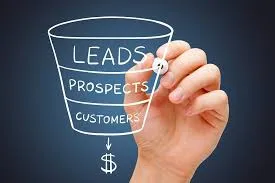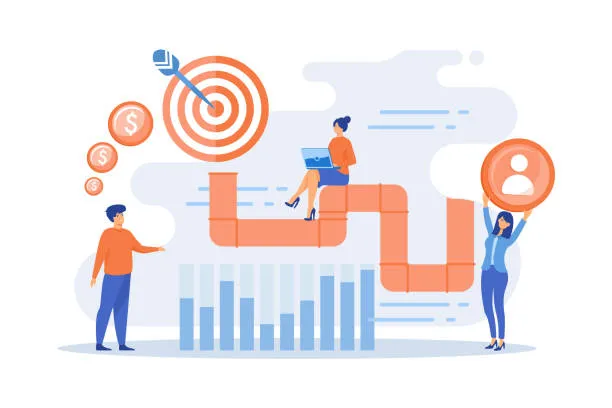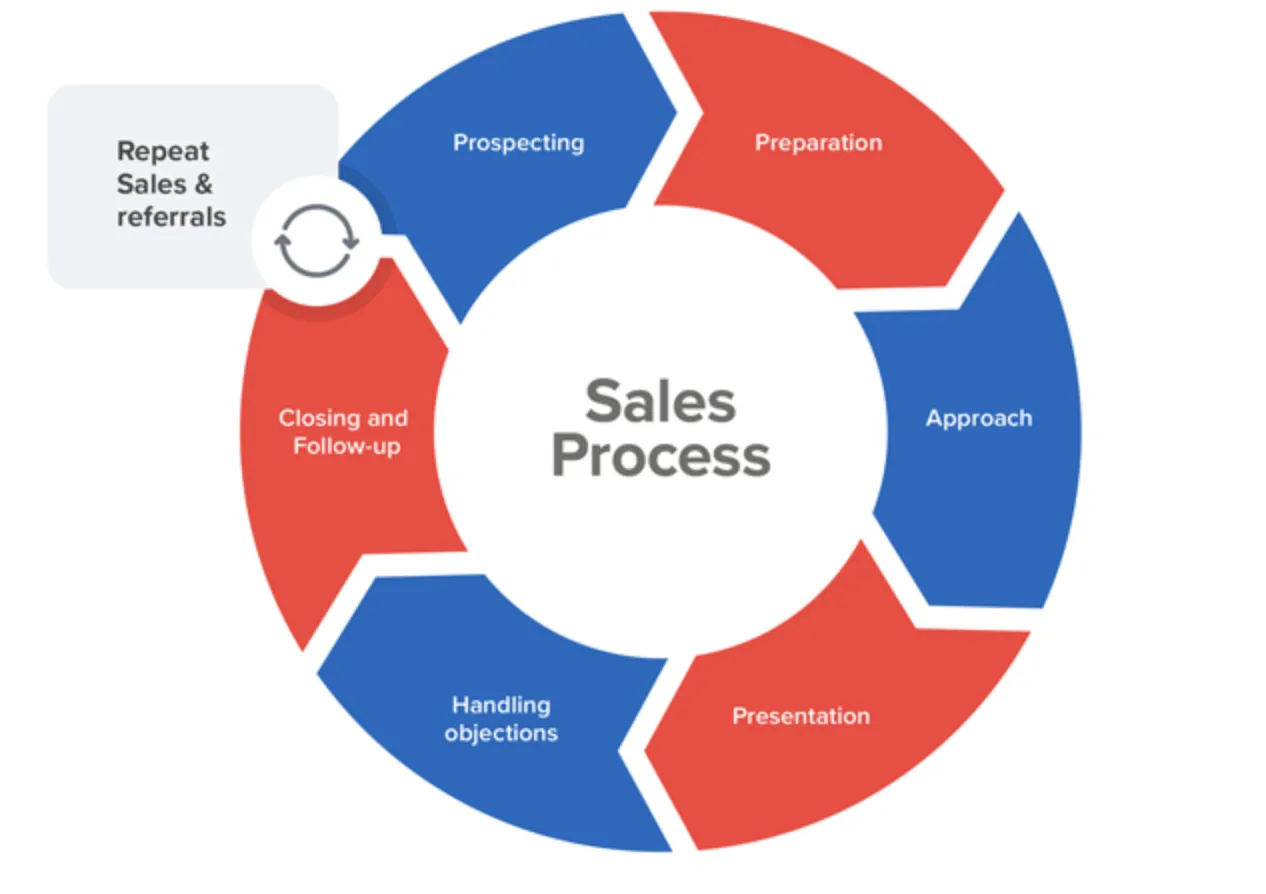The stages of a sales pipeline are the backbone of any organized sales process, helping your sales team turn potential leads into paying customers. Each stage, from prospecting to closing deals, ensures that no opportunity is overlooked, creating a structured approach to managing relationships.
According to Salesforce, businesses with a well-structured sales pipeline see a 28% increase in revenue compared to those without one. Understanding these pipeline stages not only supports your team but also aligns the entire sales funnel with your business goals.
In this article, we’ll explore each stage in detail to help you build a healthy sales pipeline that drives consistent results.
What is the definition of a sales pipeline?

A sales pipeline is a good way to depict clients as they go through the buying process.It's a highly organized approach for tracking and managing sales activities, including information about each prospect, contract, and money spent.
Sales processes are critical to gaining important insights that lead to efficiency, efficacy, and, eventually, profit.
Furthermore, since salespeople have a lot on their plates now, such as prospecting, interacting with clients, producing reports, and closing deals, they require immediate access to specific details about buyer progress.
If you don't use pipeline software in your sales management operation, you risk significant data going unrecorded.
We can't talk about what a sales pipeline is without defining what it isn't, especially because it's frequently confused with other sales words.
A sales pipeline is not the same as a sales funnel

Despite the fact that the two are quite alike and related, it's vital to remember each has its own set of characteristics. A sales funnel revolves around leads, takes place from the prospect's perspective, and displays conversion rates at each stage of the sales process.
The funnel, in essence, is a broad representation of the entire lead qualification procedure.Many sales leads enter the wide top of the funnel and few make it to the bottom as genuine consumers.
The goal of a sales pipeline is to show which sales activities must be completed in order to meet quota or revenue targets, whereas the aim of a sales funnel is to demonstrate which transactions are required in order to maximize profits.
The act of organizing your sales process into a workflow is intended to show how revenue possibilities are generated and distributed across various phases during the sales lifecycle.
“Take the first step toward success. Discover how Alore CRM can transform your sales pipeline today!"
How Does a Sales Team Use a Sales Pipeline?

A well-defined sales pipeline is essential for helping a sales team manage opportunities effectively. Below are practical ways a sales team leverages a pipeline for better results.
1. Tracking Leads in the Sales Pipeline
Tracking leads through the pipeline stages ensures no opportunity slips through the cracks. With tools like a sales CRM, the team can monitor where each lead is in the sales cycle and take timely actions.
This approach helps to maintain a steady flow of leads and allows sales reps to prioritize based on the potential prospects' progress.
2. Spotting Bottlenecks
Bottlenecks in the sales process can stall progress and impact revenue. By analyzing deal stages and identifying delays, sales managers can address issues, such as long negotiation stages or missed follow-ups.
Regular reviews of sales pipeline reports can highlight where sales efforts need improvement to maintain a healthy sales pipeline.
3. Improves Team Collaboration
The sales pipeline provides a centralized view of leads and opportunities, allowing the entire team to align their activities. Delegating sales activities becomes easier when every team member can see the current pipeline value and understand how their role contributes to reaching revenue goals.
Collaboration also improves during customer relationship management meetings, where teams discuss strategies for moving potential customers through the pipeline.
4. Forecasting Revenue
Forecasting is one of the most critical uses of a sales pipeline. By analyzing conversion rates, the sales team can predict future monthly revenue and align efforts with revenue targets.
A well-structured sales pipeline also helps
track metrics like average deal value and estimate how many deals are likely to close within a specific period.
5. Prioritizing High-Potential Leads
Not all leads are equal, and a strong sales pipeline helps the team focus on high-quality leads with the greatest potential to convert.
Using data from lead qualification and market research, sales reps can identify valuable prospects and move them to the next stage efficiently. This ensures that sales efforts are spent on leads most likely to generate results.
6. Measuring Team Performance
The pipeline also serves as a performance evaluation tool. Metrics such as the number of leads in various stages, successful negotiations, and the time spent in each stage provide insights into the overall health of the sales process.
Sales managers can use this data to support sales professionals and help them address specific pain points.
7. Aligning Strategies with the Pipeline
Aligning sales strategies with the sales pipeline ensures that the team works toward common goals. By integrating marketing campaigns with the pipeline, the sales team can create a seamless journey for prospects.
Strategies like lead nurturing and social media engagement are often used alongside pipeline data to improve outcomes.
A well-maintained sales pipeline enables the sales team to operate efficiently, make informed decisions, and achieve consistent business growth. By tracking and optimizing every stage, your team can manage opportunities with clarity and purpose, driving both revenue and long-term success.
“Empower your sales team with Alore CRM’s advanced pipeline management. Get started today!"
What Are the Sales Pipeline Stages?

You must first understand the stages that a sales pipeline comprises in order to profit from its transparency and operational efficiency.
It's crucial to remember that your company's industry and business model may impact the actual phases.
We'll look at some typical phases that are commonly found in a sales pipeline in this section:
1. Prospecting
Customers must first discover that your product and service exist before they can purchase it to address their pain points. In this phase, sellers find and contact potential leads who match the ideal buyer profile.
Sending outbound emails, cold calling, using LinkedIn to contact people, and other promotional activities are all examples of prospecting.
If your company uses inbound marketing to create leads, this phase is sometimes referred to as "lead generation."Whatever you want to call it, this period is crucial, with 82 percent of purchasers saying they're prepared to meet sellers who reach out proactively.
And since a firm loses a percentage of its customers each year through natural attrition, your staff can't afford to overlook the value of attracting potential consumers that they may convert into buyers.
Remember that increasing the number of clients lowers your risk of lost sales, so establishing a solid prospecting approach will work to your advantage.
2. Qualification
Not all potential customers are viable. Even if they match your target buyer's description, it does not necessarily imply that they will proceed through the sales process.
In reality, while 61% of B2B marketers send all direct leads to sales, only 21% of those leads will be viable.Reps who don't follow a certain set of criteria risk wasting time on leads that won't, or can't, ever buy your product or service.
Worse, they may end up buying a solution that doesn't address their problems, resulting in attrition and customer support difficulties in the long term.
Because qualification is critical to differentiate between hot and cold leads, make sure your pipeline includes a research strategy that addresses these questions for each prospect:
- Is the prospect willing and able to pay for your product or service?
- Is your solution able to solve the prospect's most pressing problem?
- Is your prospect trusted to make purchasing decisions regarding your goods or service, or do they need buy-in from other parties?
- Is the buyer prepared to make a purchase right now?
Salespeople can help prospects determine whether or not they are qualified by providing them with useful information (and understanding if they're interested in learning more).
Salespeople may benefit from a solid plan for confronting objections, which can help warm up those initially chilly leads.
3. Contact
The first stage of the pipeline, known as the qualification funnel, is rather straightforward: when a rep recognizes that a lead is qualified, they can interact with them directly.
74 percent of buyers want to hear from sellers when they're looking for a solution to their problem.
Salespeople may outperform the competition by contacting qualified prospects with a customized message and guiding leads in the correct direction.
It's critical that salespeople first research buyer concerns and develop a strong argument for how your goods or service addresses those problems, then reach out to the lead when it's still fresh.
4. Relationship Building
Strong customer relationships are critical for closing more deals and completing them faster. Customers with strong connections (as a result of a client-centric approach) may be able to sell 4 to 8% more than competitors who don't invest in close contact with clients.
Because developing rapport and enhancing trust isn't a one-and-done type of activity, this stage should ideally span the remainder of the pipeline's stages.
Reps may develop strong relationships through expert content production, sharing their company's mission, customizing each interaction, and collecting and addressing feedback in order to enhance conversions.
5. Meeting, Demo, Sales Call
Once a rep has built a connection with a prospect, it's time to actually schedule a meeting. When sellers present (and frequently demonstrate) your product or service in an attempt to validate its worth to the prospect, this is where they do it.
According to a study by research firm Gartner, just under 60% of sales meetings are unhelpful. That's a huge (and scary) number, but there are certain best practices reps may follow to guarantee success at this stage in the process.Making a positive first impression and influencing buyer choices for the better requires:
- Focusing on the specific value that your goods or service provides to the buyer
- Working with the buyer to create a collaborative action plan (MAP) that incorporates their input
- Educating the buyer with fresh viewpoints and concepts
- Recognizing the distinct obstacles in a buyer's market or sector
It may be time-consuming and stressful for busy executives and salespeople to run successful negotiations. They must frequently spend the entire meeting writing down accurate notes, which is distracting, error-prone, and difficult.
Virtual assistant technologies are utilized by modern sales organizations to enhance their meetings without sacrificing rep productivity.
Salespeople may use these technologies to gather conversation intelligence, real-time coaching, live transcription and notes, and actionable data so they can focus on the customer during meetings (and yet have accurate notes for follow-up).
6. Deal Closing
A deal does not just end when two people shake hands and agree to terms. You must first submit a comprehensive proposal that details how your product or service will meet the buyer's requirements, how the value of your services justifies their price, and how your firm provides a unique edge over competing vendors.
The buyer might then negotiate these conditions and perhaps many more times, until you and he/she reach an agreement on the work scope, cost, and managing expectations.
This may be a time-consuming component of the sales funnel because both parties must be prepared to compromise until they find a mutually beneficial deal.When it comes to closing sales, the number one challenge that 48% of salespeople confront is competing against cheaper rivals.
It's critical that your representatives know how to negotiate effectively without crumbling, so this training will serve as an effective guide for them.After these tasks are completed, it's time to sign the contract (at long last!). Some enterprises simply execute a transaction at this point, while others require signing a contract.
How Is a Sales Process Different from a Sales Pipeline?

A sales process is a structured set of steps that guides the sales team in converting prospects into paying customers. It focuses on the specific sales activities sales reps perform, such as making phone calls, qualifying leads, or presenting solutions. On the other hand, a sales pipeline represents the stages a prospect moves through during the buyer’s journey, from initial contact to closing deals.
The key difference lies in perspective. While the sales pipeline tracks where a lead is in the journey, the sales process defines how the team takes action at each stage. For example, in the sales stages of qualification, the pipeline might show a lead progressing, while the process would detail steps like asking targeted questions to identify qualified leads.
A robust sales pipeline helps visualize progress and forecast revenue growth, such as estimating the potential cash flow from upcoming deals. Meanwhile, the sales process ensures the team follows a repeatable strategy to meet sales goals. Both are essential for success, with the sales pipeline management helping to monitor progress and the process ensuring consistent actions to achieve results.
By aligning the two, businesses can optimize their target audience approach and identify opportunities to improve their effective sales pipeline strategy.
How Can You Optimize Your Sales Pipeline for Success?

Optimizing your sales pipeline involves a mix of practical strategies and consistent efforts. From simplifying the sales process to training your sales reps, each step ensures that your team operates efficiently and focuses on high-value opportunities. Below, we explore actionable ways to improve every stage of your pipeline.
1. Streamline the Process
Simplifying the sales process ensures that your team spends less time on unnecessary steps and more time connecting with sales opportunities. A well-organized pipeline eliminates confusion and creates a clear path for closing deals.
How to do it:
- Identify bottlenecks in the deal pipeline.
- Eliminate redundant steps in the purchasing process.
- Create a standard operating procedure for common tasks.
2. Focus on Quality Leads
Concentrating on high-value prospects ensures that your team’s time and resources are invested where they matter most. Focusing on valuable insights about your target audience can help refine the lead qualification process.
How to do it:
- Use data to identify leads with the highest conversion potential.
- Avoid chasing leads outside your ideal customer profile.
- Implement a scoring system to rank leads.
3. Automate Tasks
Repetitive tasks can take up a large chunk of a sales rep’s day. Automation helps free up time, allowing the team to focus on building relationships and closing deals.
How to do it:
- Use email automation for follow-ups.
- Automate task reminders for the sales reps.
- Leverage tools for managing repetitive administrative tasks.
4. Track Pipeline Metrics
Measuring key metrics helps evaluate the health of your pipeline and identify areas for improvement. Monitoring performance ensures that your team is on track to meet sales targets.
How to do it:
- Regularly review conversion rates at each stage.
- Track the average time leads spend in the pipeline.
- Monitor the success rate of your team’s sales strategy.
5. Train the Team
Investing in your sales professionals ensures they are equipped to handle objections, close deals, and manage the pipeline effectively. Skilled salespeople are a key driver of success.
How to do it:
- Conduct workshops on effective pipeline management.
- Provide tools to enhance the team’s lead generation skills.
- Offer ongoing mentorship and feedback.
6. Review and Update Regularly
An outdated sales pipeline can create inefficiencies and lead to missed opportunities. Regular reviews keep the pipeline aligned with business goals.
How to do it:
- Assess each stage of the pipeline monthly.
- Adjust strategies based on new market trends.
- Incorporate feedback from sales leaders to improve processes.
7. Use Sales Tools
The right tools simplify pipeline management and improve productivity. Modern software solutions help organize leads, monitor progress, and maintain efficiency.
How to do it:
- Use CRM tools to manage the deal pipeline.
- Invest in platforms that provide insights into the purchasing process.
- Choose tools that support integration across different departments.
By focusing on these strategies, your sales reps can work more efficiently, meet sales targets, and drive success at every stage of the pipeline. Regularly updating your processes and leveraging valuable insights ensures long-term results.
“Ready to enhance your sales pipeline? See how Alore’s intelligent solutions can help you achieve your goals!"
Conclusion
Understanding the stages of a sales pipeline is key to moving leads through a well-organized sales process. By focusing on clear stages, empowering your sales team, and maintaining a structured approach, you can turn opportunities into successful deals.
Remember, a strong pipeline isn’t just about tracking progress; it’s about creating meaningful connections with potential and existing customers. With regular updates, the right tools, and a collaborative effort, your pipeline can drive consistent growth. Start refining your process today, and watch your sales efforts translate into measurable success.
Alore CRM offers sophisticated pipeline management tools that assist you to work and managing your opportunities, as well as bringing insight to sales engagement. Learn how AI and machine learning are used in Alore CRM to help you improve pipeline health and generate reliable predictions, or try out a demo today.

.webp)







